Overview
In the fast-paced world of healthcare, providers often face emotional challenges that can weigh heavily on their ability to deliver optimal patient care. The article highlights the essential elements that should be included in an emergency medicine note template, aiming to alleviate some of these burdens. By emphasizing structured documentation—such as subjective and objective sections, assessment and plan, and disposition—healthcare professionals can find solace in a clearer, more organized approach to documentation.
Standardized terminology plays a crucial role in this process, contributing to improved communication and clinical decision-making. When documentation is clear and consistent, it fosters a collaborative environment that benefits both providers and patients. Ultimately, this structured approach can lead to better patient outcomes, creating a more fulfilling experience for everyone involved.
As you reflect on your own practices, consider how implementing these strategies might ease your administrative load and enhance the care you provide. By embracing these vital elements in your documentation, you can not only improve your workflow but also nurture the relationships you have with your patients. Together, let’s strive for a more compassionate and efficient healthcare environment.
Introduction
In the high-stakes world of emergency medicine, where every second counts, the significance of precise documentation is profound. For healthcare providers, an effective emergency medicine note template is not just a tool; it’s a lifeline that ensures vital information is captured accurately and efficiently. This article explores ten essential elements that make up a robust emergency medicine note template, highlighting how these components enhance clinical decision-making and improve patient care. Yet, amidst the growing complexity of documentation and the emotional toll it takes on providers, one must ask: how can healthcare professionals balance thorough record-keeping with the urgent need to focus on patient care?
CosmaNeura: Streamline Emergency Medicine Documentation with AI-Powered Solutions
In today's fast-paced healthcare environment, the emotional challenges faced by providers can be overwhelming. CosmaNeura understands this struggle and harnesses cutting-edge AI technology to revolutionize the use of the emergency medicine note template in documentation. By significantly alleviating the administrative burden, healthcare providers can focus more on what truly matters—caring for their patients. Imagine a world where clinicians spend less time on paperwork and more time delivering compassionate care tailored to individual needs.
By automating crucial tasks such as client intake and triage, CosmaNeura's platform enhances operational efficiency while aligning with the ethical principles of Catholic teachings. This innovative approach not only supports healthcare providers but also ensures that care remains centered on compassion. The AI-powered solutions offered by CosmaNeura include real-time transcription and summarization of telehealth sessions, essential for preserving precise records and minimizing errors.
In emergency settings, where timely and accurate information can be the difference between life and death, utilizing an emergency medicine note template is indispensable. For instance, during a recent implementation, the AI technology facilitated over 303,000 interactions in just ten weeks, showcasing its effectiveness in improving documentation efficiency. How reassuring it must be to know that such technology is available to support healthcare providers in their critical work.
Moreover, the platform's ability to analyze user interactions aids in clinical decision-making by providing diagnostic differential suggestions, further streamlining workflows. With a , CosmaNeura's AI captures vital details precisely, reinforcing the commitment to ethical medical practices and improved patient outcomes. Together, we can embrace solutions that not only enhance efficiency but also nurture the compassionate care that every patient deserves.

Subjective Section: Capturing Patient History and Presenting Complaints
The subjective section of an emergency medicine note template is vital for capturing the individual's history and presenting complaints. This section should include detailed accounts of the individual's symptoms, their duration, and relevant medical history. By effectively using an emergency medicine note template to document this information, healthcare providers can gain valuable insights into the individual's experience, which is crucial for tailoring their clinical approach.
Consider how a well-crafted subjective section might include the individual's own words describing their discomfort, such as a report of 6/10 pain in the right shoulder, alongside any previous treatments they have undergone and their expectations for the visit. Utilizing the can assist in capturing detailed pain descriptions, ensuring that all pertinent aspects of the individual's pain are documented. This information is not only essential for creating a thorough evaluation but also ensures that the individual's perspective remains central to their support process.
To optimally record client complaints in emergency services, utilizing an emergency medicine note template that employs objective statements, avoids subjective language, and includes direct quotes from individuals is important to accurately convey their concerns. Additionally, incorporating timestamps can help monitor the timing of occurrences related to individuals' treatment. By following these practices, healthcare providers can create clearer, more reliable records that support clinical decision-making and enhance care for individuals.
Reflecting on these strategies, how can we ensure that every individual's voice is heard? By embracing these methods, we can foster a more compassionate and effective healthcare environment.
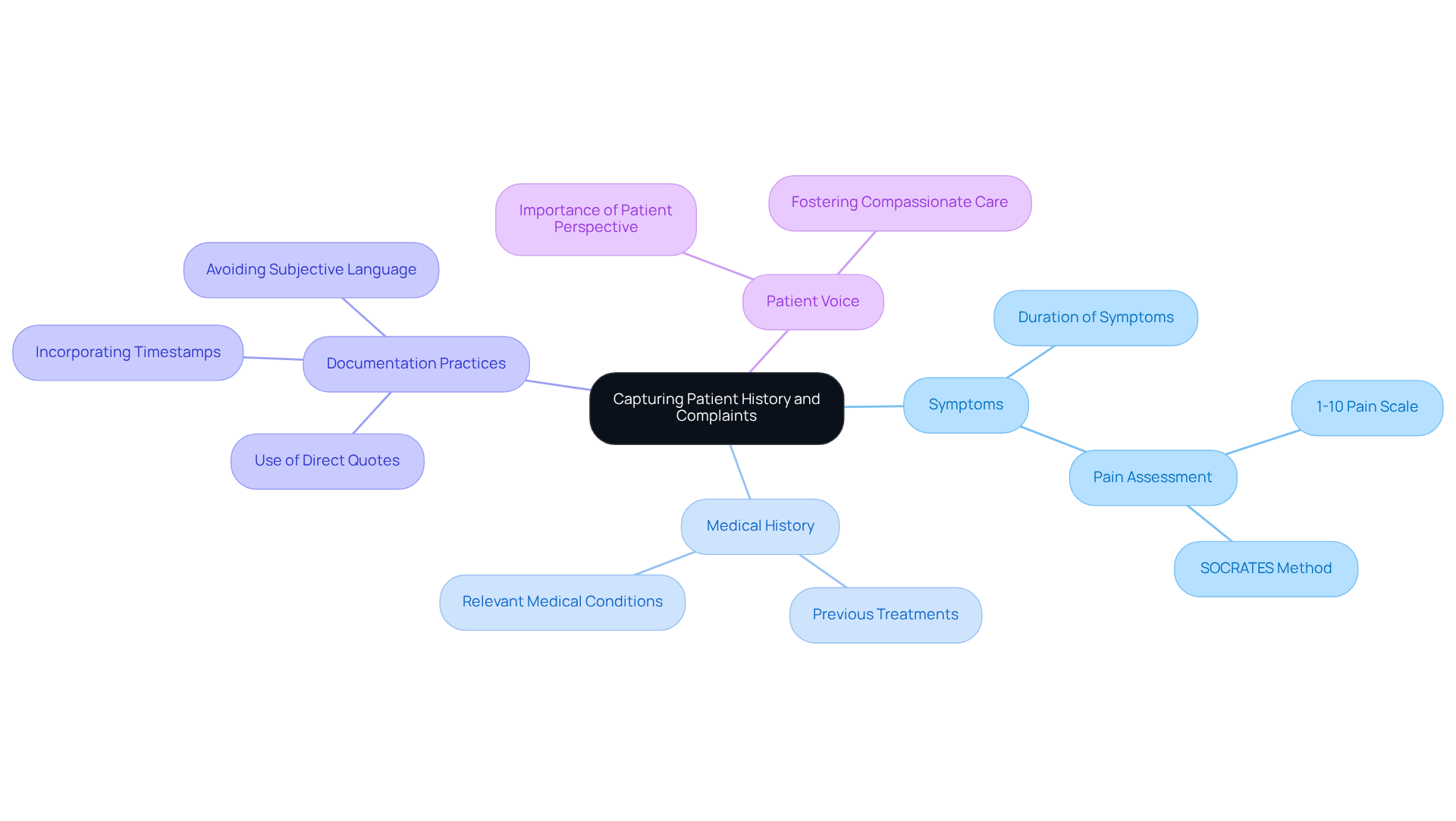
Objective Section: Documenting Clinical Findings and Observations
In emergency medicine, the emergency medicine note template's objective section plays a vital role in capturing measurable data, such as vital signs, physical examination findings, and diagnostic test results. This section lays the factual foundation for clinical decision-making, which can feel overwhelming at times, particularly when utilizing an emergency medicine note template. By recording an individual's blood pressure, heart rate, and visible physical signs, clinicians can quickly assess a person's condition and determine the necessary interventions.
However, precise record-keeping is more than just a procedural formality; it significantly influences health outcomes. Have you ever considered how well-structured and clear charts provide a real-time overview of a patient's condition, especially in high-acuity situations? This clarity is essential for effective care.
Moreover, leveraging generative AI tools can transform this documentation process. These tools automatically integrate data from electronic health records, streamlining administrative tasks and ensuring that all pertinent information is easily accessible and accurately recorded. Not only does this enhance efficiency, but it also supports clinicians in delivering timely and effective care.
Ultimately, improving interactions and outcomes while that often lead to physician burnout is crucial. Together, we can advocate for solutions that ease these challenges, allowing healthcare providers to focus on what truly matters: caring for their patients.
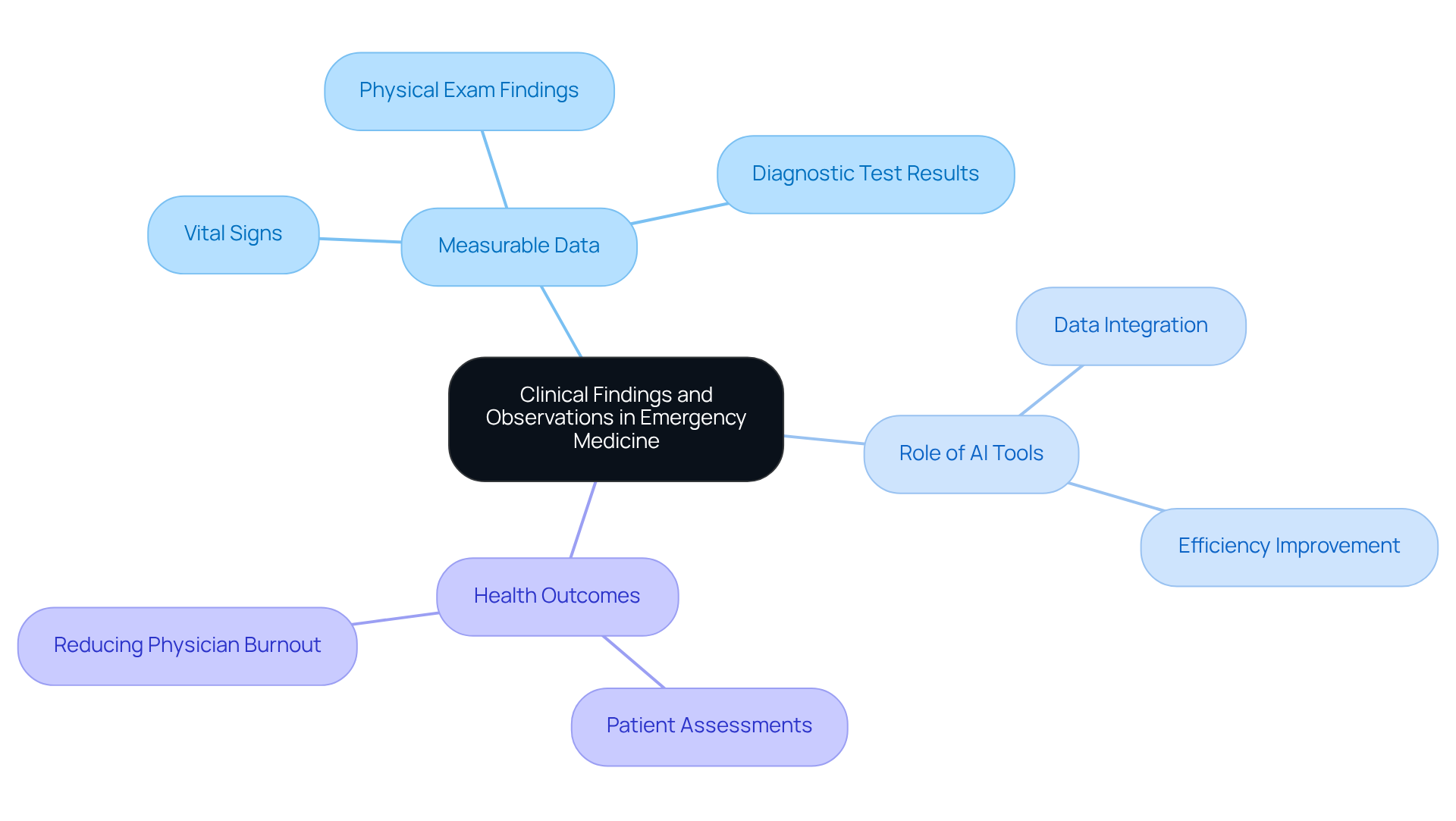
Assessment/Plan Section: Summarizing Evaluations and Outlining Treatment Plans
The assessment and plan section is a vital part of the clinician's evaluation, summarizing the individual's condition and outlining a thoughtful treatment strategy. This encompasses differential diagnoses, treatment options, and follow-up plans, all aimed at providing the best care possible.
Consider a scenario where an individual presents with chest pain. The evaluation may explore potential causes, such as myocardial infarction or anxiety. Following this, a comprehensive strategy that includes further testing, medication, and education is developed. This approach not only addresses immediate concerns but also empowers the individual with knowledge about their health.
Thorough documentation in this section is crucial for creating an effective . It ensures that all healthcare professionals involved in the individual's care are aligned on the treatment strategy. This coordination fosters a safer environment and enhances outcomes, ultimately leading to improved patient satisfaction. By prioritizing clear communication and collaboration, we can navigate the complexities of healthcare together, ensuring that every individual receives the compassionate care they deserve.
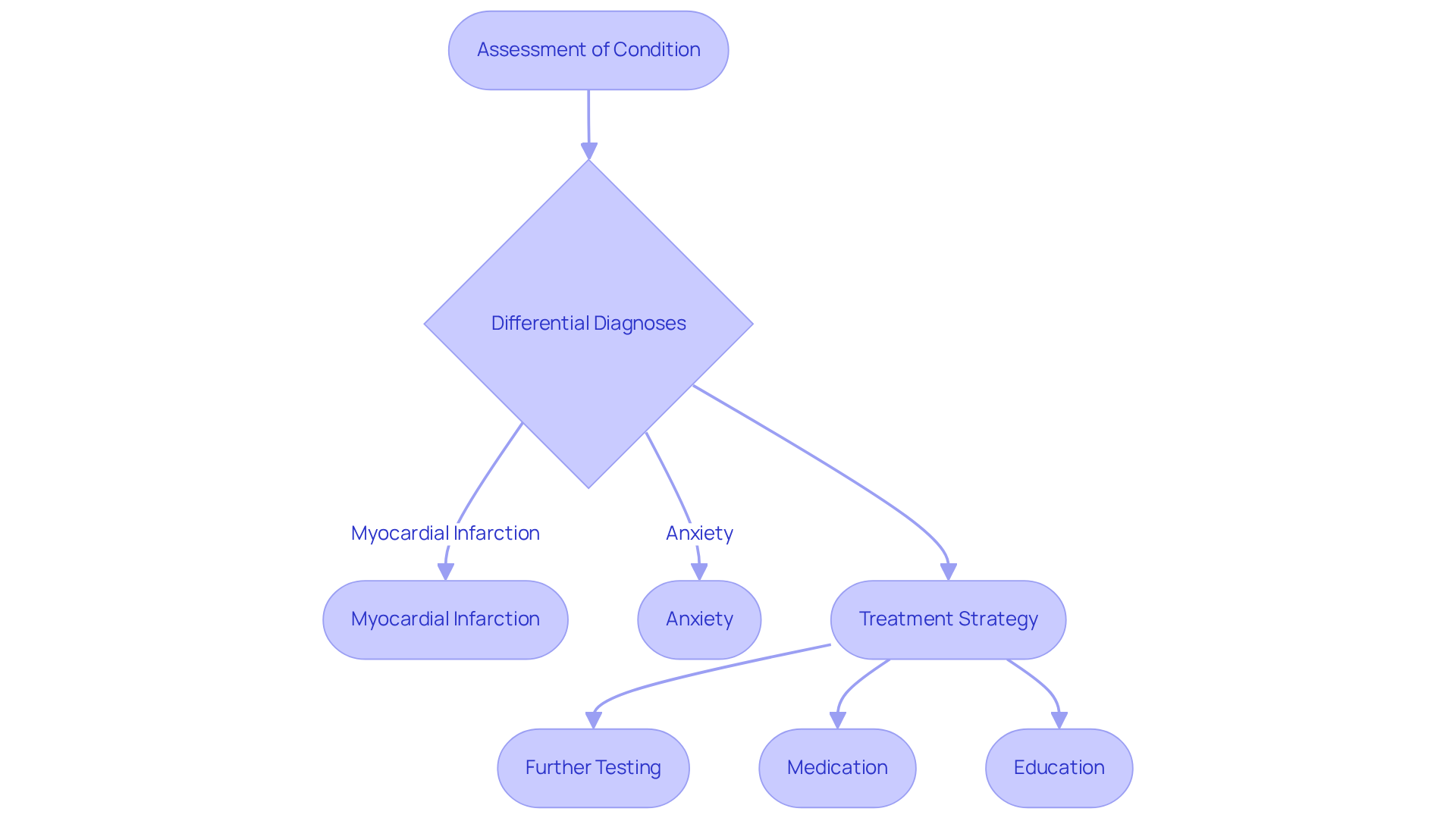
Disposition: Guiding Next Steps in Patient Care
The disposition section of an emergency medicine note template is vital, as it outlines the next steps for the individual. This determination—whether they will be discharged, admitted to the hospital, or referred to a specialist—stems from the earlier assessment and plan documented by the healthcare provider. For instance, if someone is diagnosed with a serious infection, the disposition may recommend admission for intravenous antibiotics, ensuring they receive prompt and appropriate treatment.
Accurate records of the disposition are essential for effective communication among team members, facilitating smooth transitions in care. Have you ever considered the impact of avoidable medical mistakes? Research indicates that these errors lead to approximately 98,000 fatalities each year in U.S. hospitals. This statistic underscores the importance of to enhance safety for individuals receiving care. Moreover, the use of an emergency medicine note template with efficient disposition sections can significantly influence patient outcomes by guiding follow-up decisions and ensuring that all healthcare practitioners are aligned in their approach.
What might effective disposition sections look like? They could include specific instructions for follow-up appointments, referrals to specialists, or detailed discharge instructions that empower individuals to manage their health after their visit. By clearly outlining these upcoming actions, healthcare professionals can improve the continuity of service and elevate overall client satisfaction. Let’s work together to enhance our practices and ensure that every individual receives the care they deserve.
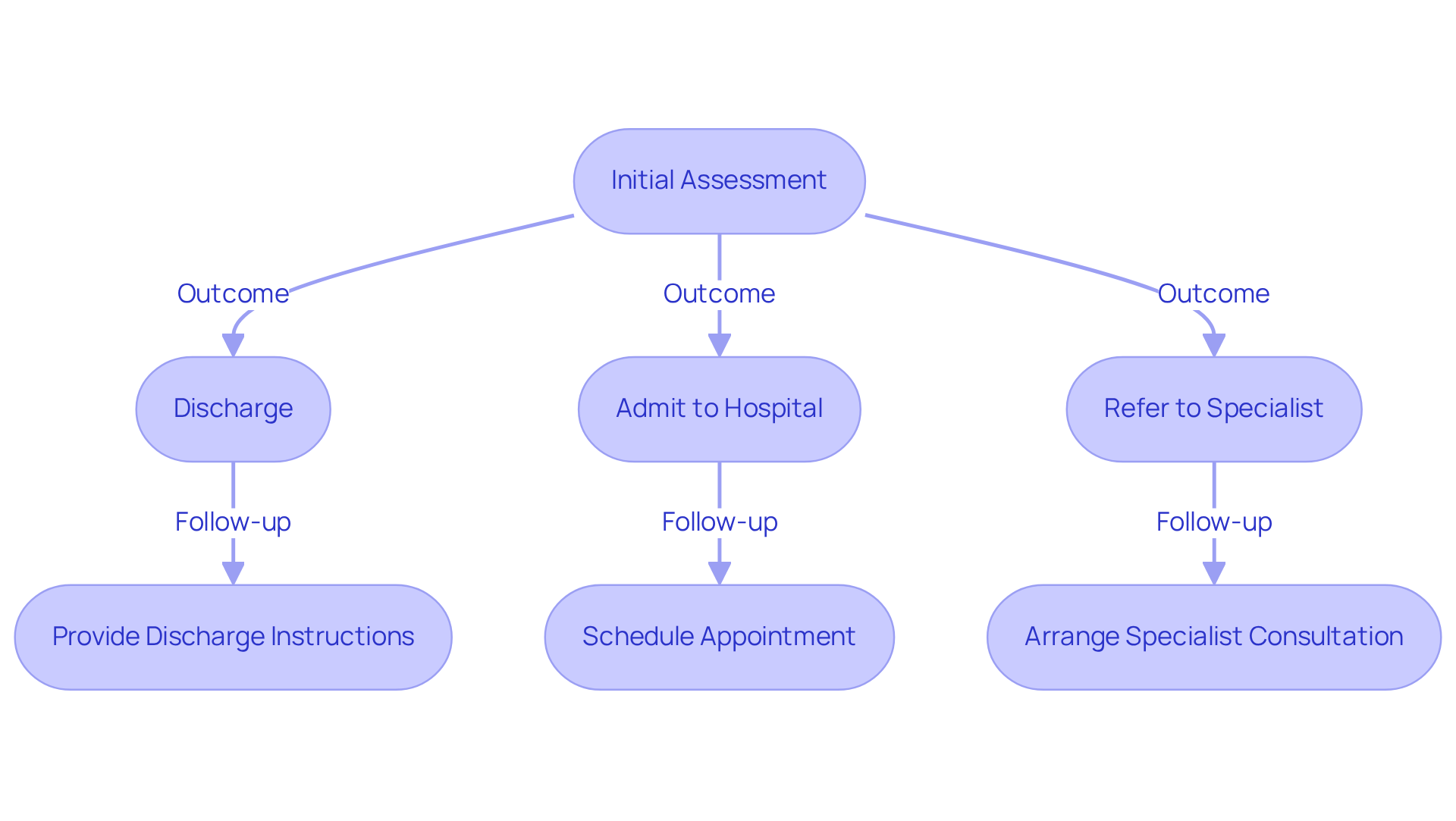
Summary: Enhancing Communication Among Healthcare Providers
The summary portion of an emergency medicine note template plays a vital role in consolidating key findings and choices made during client encounters. Have you ever considered how brief documentation of an individual's history, clinical observations, evaluation, and strategy serves as a quick reference for all healthcare professionals involved in their care? In emergency situations, where multiple providers may engage with an individual, timely and precise information exchange is crucial for enhancing outcomes. Studies reveal that emergency medicine practitioners dedicate 55-89% of their time to communication tasks, highlighting the necessity for effective summarization during encounters with individuals receiving care. Effective communication can significantly reduce delays and improve safety for those in need.
Furthermore, the incorporation of organized summary sections in the emergency medicine note template promotes collective understanding among team members, ensuring that everyone is aligned on the individual's health status and care plan. This alignment is especially crucial in high-pressure settings, where rapid decision-making can mean the difference between favorable and unfavorable outcomes for individuals. By leveraging generative AI, healthcare professionals can streamline the summarization process, automate administrative tasks such as scheduling and managing medical records, and reduce the overall administrative burden. This shift allows for a greater focus on patient care.
Additionally, implementing best practices for improving communication between EM physicians and nurses can further enhance the effectiveness of the emergency medicine note template. Addressing barriers to communication, such as environmental factors and EHR implementation, is also critical for optimizing information exchange in emergency departments. Continuous training for EM professionals on communication and non-technical skills nurtures a culture of effective collaboration. Together, we can create a more for both healthcare providers and the individuals they serve.
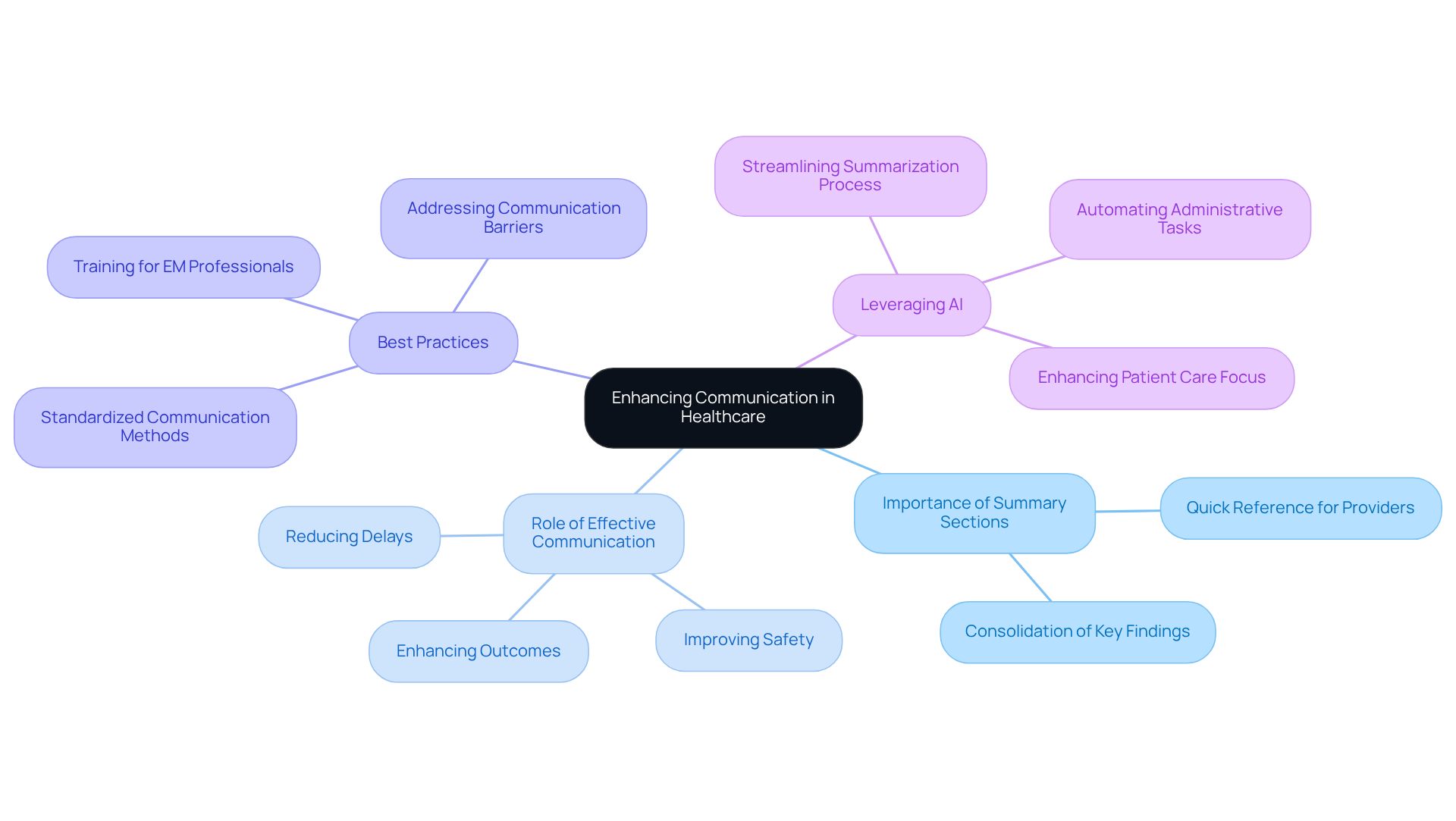
Structured Format: Ensuring Consistency and Clarity in Documentation
Implementing an emergency medicine note template is essential for capturing all necessary information consistently. Have you ever felt overwhelmed by the sheer volume of paperwork? This method features distinctly outlined segments for subjective, objective, assessment, and plan (SOAP) records, which not only improves clarity but also enables faster evaluations by healthcare professionals. Using an emergency medicine note template can significantly ease the , minimizing the time spent on paperwork while ensuring that essential information is not overlooked.
Generative AI can further alleviate the burden on healthcare providers by streamlining various administrative tasks, such as scheduling appointments and managing medical records. Research shows that utilizing organized formats can lead to a decrease of up to 872 words in text length, enhancing the management of individuals. Imagine the relief of having more time to focus on patient care rather than being bogged down by administrative duties.
Moreover, the implementation of organized records has been shown to enhance overall client satisfaction and health outcomes. This highlights the importance of clarity and consistency in clinical notes. By prioritizing organized formats, the use of an emergency medicine note template in emergency departments can improve record-keeping efficiency, ultimately benefiting both caregivers and individuals. Let's work together towards a more efficient and compassionate healthcare environment.
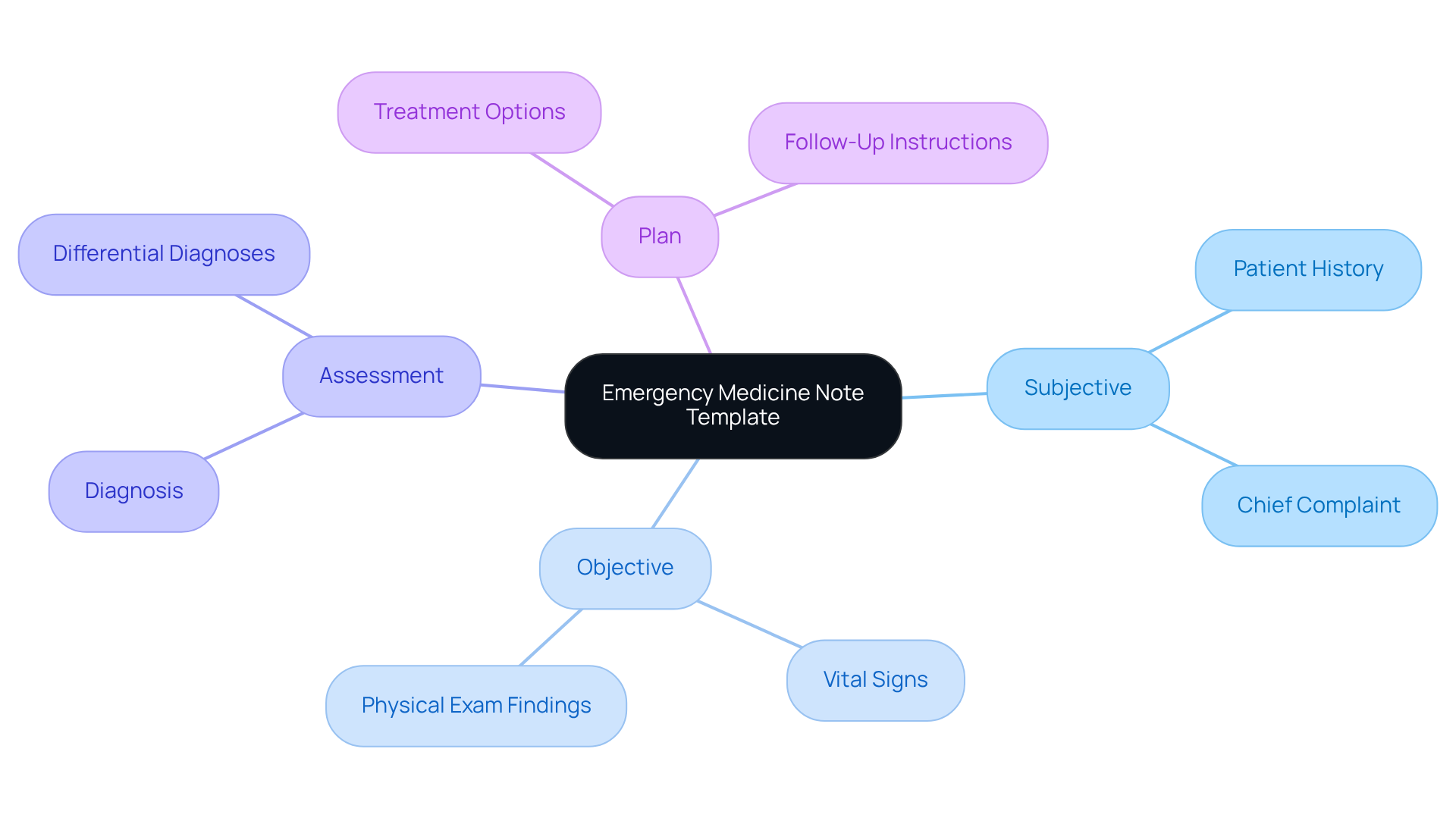
Timeliness: Ensuring Effective Patient Care and Legal Compliance
Timeliness in documentation is crucial in emergency medicine note template, where rapid decision-making can profoundly impact patient outcomes. Healthcare professionals often face emotional challenges, and recording encounters promptly is essential to ensure accuracy and completeness. For example, the use of an emergency medicine note template to document vital signs and treatment choices immediately after they occur helps maintain a precise timeline of service, vital for both clinical and legal reasons.
Generative AI tools present a compassionate solution, enabling healthcare providers to streamline documentation efficiently. By automating the entry of vital signs and treatment decisions, as well as managing medical records and scheduling appointments, these tools alleviate the administrative burden on physicians. This allows them to focus more on caring for individuals, fostering a nurturing environment.
Moreover, these like labor shortages and physician burnout, enhancing healthcare delivery and leading to better outcomes for those receiving care. Imagine a world where healthcare professionals can devote their energy to what truly matters—their patients. Let’s explore how embracing these innovations can create a more supportive and effective healthcare system for everyone.
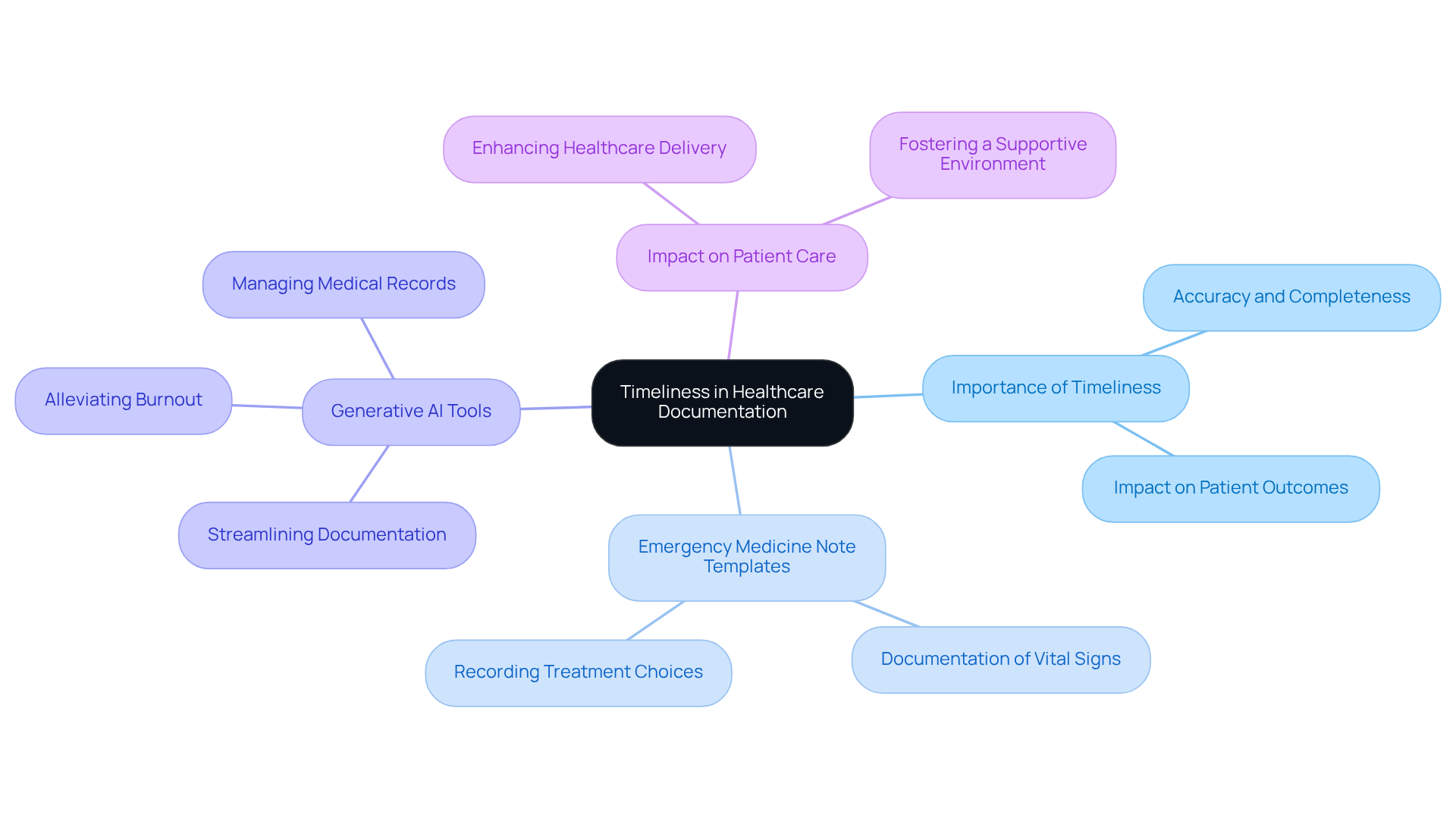
Standardized Terminology: Improving Clarity and Reducing Miscommunication
In emergency medicine, using standardized terminology in documentation is essential for fostering a shared language among healthcare professionals. This consistency not only aids in clear communication but also minimizes misunderstandings that could lead to treatment errors. Have you ever considered how vital it is for everyone on the team to be on the same page? Studies show that using universally accepted terms for diagnoses and procedures can significantly enhance clarity, with a sensitivity estimate of 86.3% and specificity of 99.4% in clinical settings, ultimately promoting patient safety.
Training healthcare professionals in goes beyond improving communication; it nurtures a culture of safety within healthcare environments. The case study on 'Training for Emergency Department Scribes' highlights how effective training ensures that scribes can navigate real ED workflows, which is crucial for accurate record-keeping. By equipping providers with the necessary terminology, they can articulate patient needs more precisely, enhancing overall service quality. Additionally, integrating standardized language into documentation processes has been shown to improve workflows, making it easier to manage patients in high-pressure situations like emergency departments.
Embracing standardized terminology in daily practice is not just about compliance; it reflects a commitment to delivering safe and effective care. As Suzi Mattox wisely states, "Medical terminology aids in avoiding errors in diagnoses and treatments by ensuring that everyone involved in a person's treatment comprehends the same information, decreasing the likelihood of mistakes." In a rapidly evolving healthcare landscape, the importance of clear and consistent communication is paramount. Standardized terminology stands as a foundational pillar in our pursuit of excellence in emergency medicine, encouraging us all to engage in this vital practice through the use of an emergency medicine note template.
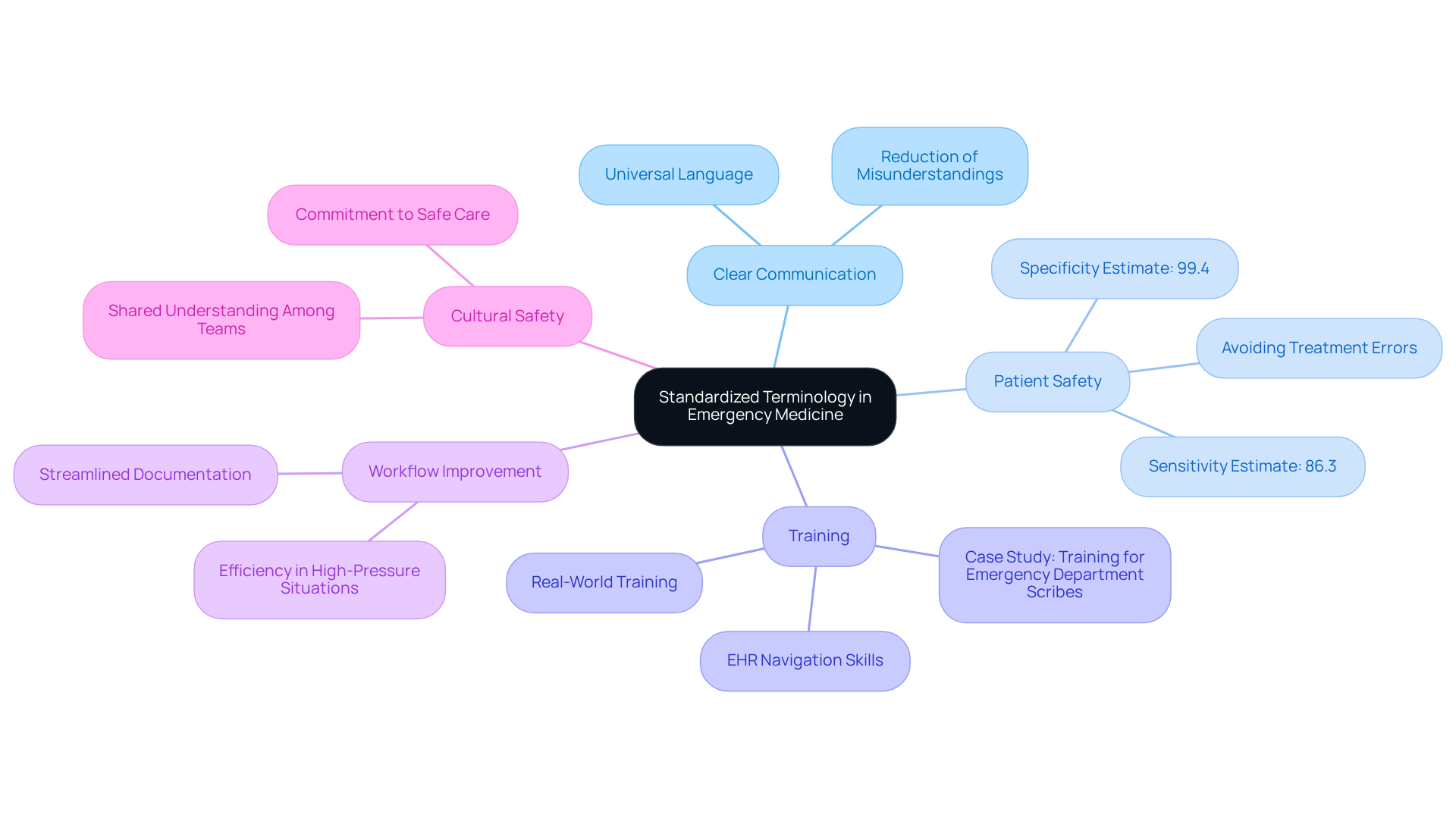
Ethical Considerations: Aligning Documentation with Catholic Teachings
Incorporating ethical considerations into emergency medicine records is essential for providers who are committed to Catholic teachings. This commitment involves ensuring that all records respect individual dignity and confidentiality while accurately reflecting the services provided. How can we record client interactions in a way that honors their values and beliefs? This is particularly crucial in faith-based healthcare environments.
Educating staff on ethical recording practices is vital, as it emphasizes the importance of compassion and respect in every interaction. By cultivating an atmosphere aligned with Catholic values, healthcare professionals can significantly enhance the standard of treatment while maintaining respect for each individual.
Furthermore, utilizing CosmaNeura's AI platform can streamline documentation processes, ensuring that ethical standards are consistently upheld. This technology allows providers to focus more on , ultimately leading to improved job satisfaction and adherence to Catholic teachings. How can we address key healthcare challenges while respecting and enhancing the human experience? By embracing innovative solutions, we can create a more compassionate healthcare environment.
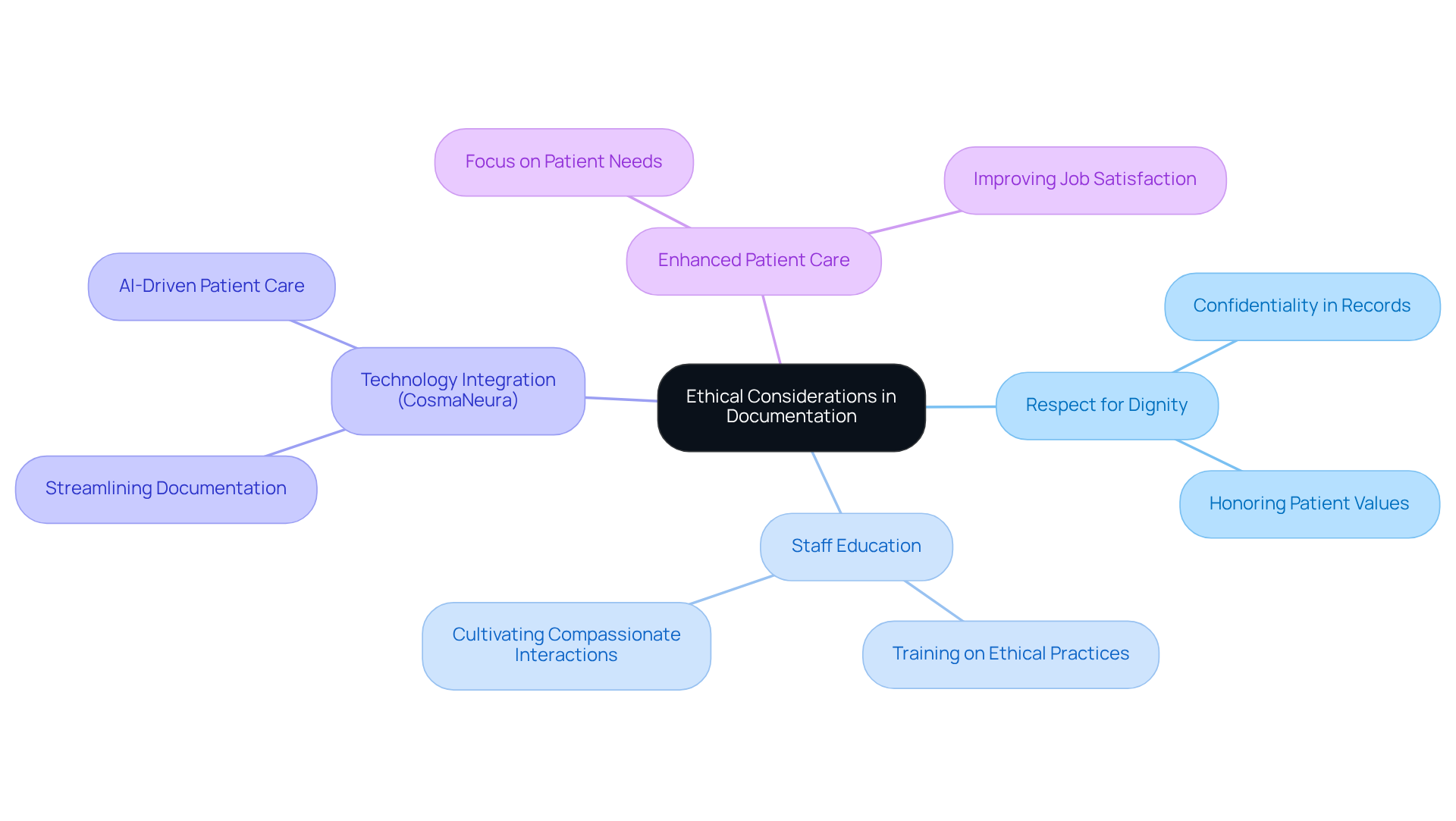
Conclusion
The integration of essential elements in an emergency medicine note template is crucial for enhancing the quality of patient care. Have you ever felt overwhelmed by the demands of documentation? By focusing on structured documentation, healthcare providers can alleviate some of these burdens, streamline their processes, and ultimately prioritize patient well-being. Innovative technologies, particularly AI solutions like those offered by CosmaNeura, illustrate how modern tools can transform the recording and communication of medical information.
Key components such as the subjective and objective sections, assessment and plan, and disposition are vital for effective documentation. Each section serves a distinct purpose, ensuring that healthcare professionals capture comprehensive patient histories, clinical findings, and treatment strategies. By emphasizing standardized terminology and timely documentation, we reinforce the importance of clarity and consistency in emergency medicine notes—elements that can significantly impact patient outcomes and safety.
Reflecting on these practices, it's clear that adopting a well-structured emergency medicine note template is more than just a procedural necessity; it represents a commitment to delivering compassionate and effective care. By embracing these best practices and leveraging advanced documentation solutions, healthcare professionals can cultivate an environment that prioritizes both efficiency and empathy. The call to action is evident: investing in robust documentation strategies is essential for fostering a healthcare system that truly serves the needs of every individual, ensuring their voices are heard and their care is optimized.




